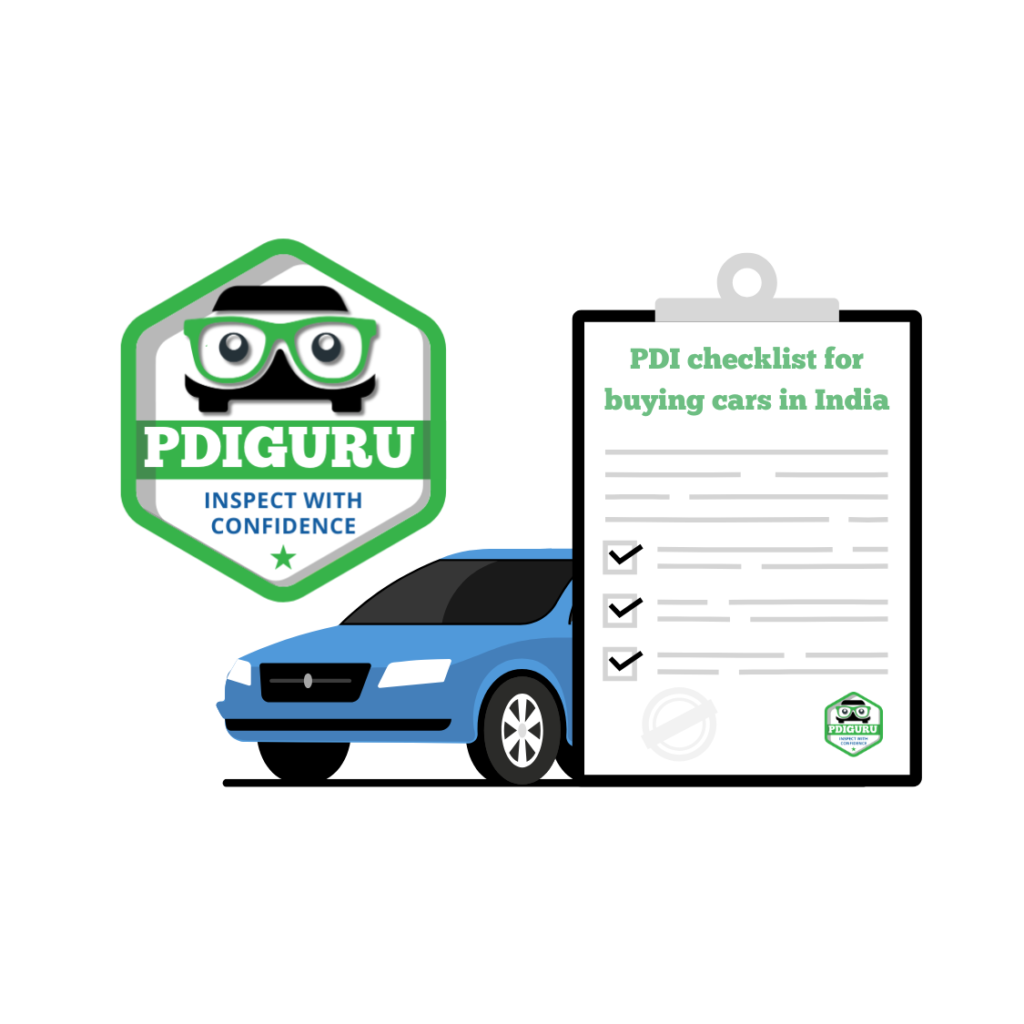When you buy a new or used car, a vehicle inspection report (VIR) is typically presented to reassure you that the vehicle has passed necessary checks before delivery. While these reports offer valuable insights, they often fail to highlight hidden issues that may affect your car’s long-term performance. Understanding vehicle inspection reports is essential for making an informed decision and avoiding unpleasant surprises later.
In this article, we’ll explore what a vehicle inspection report doesn’t reveal and how you can spot issues that may not be listed. By following a comprehensive Pre-Delivery Inspection (PDI) checklist, you’ll ensure that you’re getting the best possible vehicle in terms of condition and safety.

What’s Included in a Standard Vehicle Inspection Report?
A typical vehicle inspection report is a checklist that covers essential aspects of the vehicle, such as:
- Exterior condition: Scratches, dents, paint quality, etc.
- Tire condition: Tread depth, alignment, and pressure.
- Mechanical systems: Engine, transmission, suspension, etc.
- Electronics and systems: Lights, air conditioning, infotainment, sensors, etc.
- Interior condition: Seats, upholstery, dashboard, and controls.
This vehicle inspection report provides a quick overview of the vehicle’s visible condition, but it may not give you the full picture of the car’s overall health.
PDIGuru Pro Tip
“While a vehicle inspection report is helpful, it usually only highlights the visible or easily detectable issues. Hidden problems, such as mechanical flaws or advanced software glitches, might not be covered.”
What Vehicle Inspection Reports Don’t Tell You

Although a vehicle inspection report can give you peace of mind, it often leaves out important details. Here are some things typically not covered by these reports:
1. Hidden Mechanical or Structural Damage
The vehicle inspection report might highlight visible damage, but it usually doesn’t address hidden structural issues, such as frame damage from a past accident. These kinds of problems can affect the car’s safety and performance, even if they aren’t immediately visible.
2. Pre-Existing Software Issues
Many modern vehicles rely on sophisticated software to run everything from infotainment to advanced driver-assistance systems. A simple vehicle inspection report might not detect software glitches that could affect how well these systems function.
3. Fluid Levels and Quality
While the vehicle inspection report may mention fluid levels, it doesn’t always account for the quality of fluids or whether they are contaminated. Old or dirty fluids, such as engine oil or coolant, can result in engine or system malfunctions over time.
4. Long-Term Wear and Tear
The vehicle inspection report generally focuses on the vehicle’s immediate condition. It might not highlight signs of long-term wear and tear, such as brake pad wear, battery life, or suspension issues, that could require attention soon.
5. Prior Owner’s History (For Used Cars)
For used cars, the vehicle inspection report often doesn’t provide information about the vehicle’s past history, including any accidents or major repairs. These hidden details can significantly affect the car’s future reliability and safety.
Why You Need to Be Aware of These Issues
Before you can effectively address the issues in a vehicle inspection report, you must be aware of the potential problems. A comprehensive Pre-Delivery Inspection (PDI) checklist can help you identify both the obvious and hidden concerns in a vehicle. This checklist ensures that you don’t miss anything crucial when assessing the car’s condition.
Armed with a complete understanding of the car’s potential issues, you’ll be better prepared to tackle any discrepancies that may arise, either through direct communication with the dealership or through third-party inspections.
How to Spot Hidden Issues in Your Vehicle Inspection Report

Understanding the gaps in a vehicle inspection report allows you to spot hidden issues more effectively. Here are some proactive steps you can take:
1. Do Your Own Visual Inspection
Even though a vehicle inspection report highlights visible damage, it might miss subtle issues. Perform your own visual inspection, especially in hard-to-see areas. Look for:
- Paint imperfections or dents
- Underneath the car for leaks, rust, or damage
- Uneven tire wear
PDIGuru Pro Tip
“Use multiple light sources, such as a flashlight or direct sunlight, to examine the car’s paintwork. Some scratches or chips can be hard to spot under low light.”
Actionable Steps:
- Walk around the vehicle, inspecting each panel and the undercarriage.
- Use a flashlight to inspect the underside for rust or leaks.
2. Test All Electronic Systems Thoroughly
The vehicle inspection report may note that all electronic systems are functional, but it’s important to test everything yourself. Thoroughly check the infotainment system, sensors, A/C, and parking assistance features to ensure they are working as expected.
PDIGuru Pro Tip
“Sometimes, electronic systems have minor glitches that don’t appear during a basic inspection. Use the system extensively to test its performance. Try connecting Bluetooth, making calls, and using the navigation system.”
Actionable Steps:
- Test the infotainment system’s features, including Bluetooth and media settings.
- Ensure the air conditioning and heating systems work properly, adjusting settings for both.
3. Hire a Third-Party Inspector
Even though dealerships perform their own inspections, a third-party mechanic can provide an unbiased evaluation. Third-party inspectors have the expertise to spot issues that may not be covered by the vehicle inspection report, such as hidden mechanical problems or worn-out components.
PDIGuru Pro Tip
“If you’re concerned about hidden problems, especially with used cars, hiring a professional inspector can save you money and stress down the line.”
Actionable Steps:
- Hire a trusted mechanic for an independent inspection.
- Request a detailed report that includes both visible and potential hidden issues.
4. Review Service Records (For Used Cars)
For used cars, it’s essential to review the service records, which the vehicle inspection report typically doesn’t provide. These records reveal the car’s maintenance history, any major repairs, and whether the vehicle has been involved in accidents.
PDIGuru Pro Tip
“Check for gaps in the service history. If there’s no record of regular maintenance or if repairs were done by unauthorized mechanics, it might be a red flag.”
Actionable Steps:
- Ask the dealership or seller for complete service history records.
- Verify any significant repairs and ensure they were performed by authorized service centers.
What to Do If You Find Discrepancies in the Vehicle Inspection Report

If you spot any discrepancies between what’s noted in the vehicle inspection report and what you’ve observed, it’s important to address these issues promptly. Being aware of potential problems allows you to take informed action and ensures that you’re not stuck with a vehicle that doesn’t meet your expectations.
PDIGuru Pro Tip
“Document your findings with photos and videos to provide clear evidence when discussing the issue with the dealership. This will help you resolve the matter more efficiently.”
Actionable Steps:
- Contact the dealership and point out any issues you’ve found that weren’t mentioned in the vehicle inspection report.
- Use evidence like photos and videos to support your concerns and negotiate a solution, such as repairs or price adjustments.
If you need more guidance on handling these types of situations, we’ve written a dedicated blog on “How to Handle PDI Issues and Dealership Complaints Effectively: A Guide for Car Buyers” This resource will help you navigate the next steps when dealing with discrepancies and ensure you have a smooth resolution process.
Common Issues Found During Pre-Delivery Inspection (PDI) and How to Address Them
During a Pre-Delivery Inspection (PDI), several common issues may arise that could impact the vehicle’s performance and safety. Some of the most frequent problems include engine oil leaks, worn-out tires, brake issues, and suspension problems. Additionally, electrical system malfunctions, such as faulty lights or power window failures, are often found during inspections. In India, cars may also show signs of corrosion, especially around the undercarriage, due to exposure to humidity and rough road conditions. These issues may not always be obvious at first glance but can lead to costly repairs down the road. To help you identify and address these common problems, we’ve curated a dedicated blog on the Common Issues Found During Pre-Delivery Inspection (PDI) and How to Address Them. Be sure to check it out for an in-depth look at what to watch for when inspecting your new car.
Conclusion
A vehicle inspection report is an essential tool in the car-buying process, but it’s not always comprehensive. By understanding the limitations of the report and using a thorough Pre-Delivery Inspection (PDI) checklist, you can uncover hidden issues before they become costly problems. The key is to be proactive and informed, ensuring that your vehicle is in optimal condition before taking ownership.
PDIGuru Pro Tip
“Treat the vehicle inspection report as a starting point. A detailed inspection by you, or with the help of professionals, will ensure you’re making a sound investment.”
Frequently Asked Questions (FAQs)
While dealership reports are usually thorough, they can sometimes miss hidden issues or be biased towards ensuring the sale. It’s always good to verify the report with your own inspection.
To ensure a comprehensive PDI, it’s essential to check every detail of your car, from the exterior to the electrical systems. Our Pre-Delivery Inspection (PDI) Checklist for Cars in India covers all key areas, including common issues like scratches, misaligned parts, and tire defects. Download our detailed checklist for step-by-step guidance on performing a thorough inspection. It includes expert tips and space for notes to help you catch potential issues before delivery.
If you have concerns about the vehicle’s condition, especially for used cars, hiring a third-party mechanic is a good investment to avoid costly surprises later.
If you identify an issue not covered in the inspection report, immediately raise the concern with the dealership. Document the problem with photos and negotiate a solution. To help you with this we have curated a dedicated blog on How to Handle PDI Issues and Dealership Complaints Effectively: A Guide for Car Buyers. Be sure to check it out for an in-depth understanding on handling the issues better.
Want to ensure your car is in perfect condition before you take delivery?
Download our comprehensive PDI checklist for step-by-step guidance to inspect your car like a pro!



